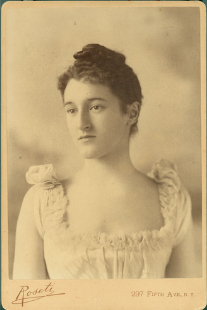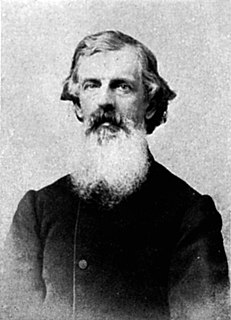Related Research Articles

Beatrix Cadwalader Farrand was a landscape gardener and landscape architect in the United States. Her career included commissions to design about 110 gardens for private residences, estates and country homes, public parks, botanic gardens, college campuses, and the White House. Only a few of her major works survive: Dumbarton Oaks in Washington, D.C., the Abby Aldrich Rockefeller Garden on Mount Desert, Maine, the restored Farm House Garden in Bar Harbor, the Peggy Rockefeller Rose Garden at the New York Botanical Garden, and elements of the campuses of Princeton, Yale, and Occidental.

Mount Washington, called Agiocochook by some Native American tribes, is the highest peak in the Northeastern United States at 6,288.2 ft (1,916.6 m) and the most topographically prominent mountain east of the Mississippi River.

John Torrey was an American botanist, chemist, and physician. Throughout much of his career, Torrey was a teacher of chemistry, often at multiple universities, while at the same time pursuing botanical work. Dr. Torrey's botanical career focused on the flora of North America. His most renowned works include studies of the New York flora, the Mexican Boundary, the Pacific railroad surveys, as well as the uncompleted Flora of North America.

Asa Gray is considered the most important American botanist of the 19th century. His Darwiniana was considered an important explanation of how religion and science were not necessarily mutually exclusive. Gray was adamant that a genetic connection must exist between all members of a species. He was also strongly opposed to the ideas of hybridization within one generation and special creation in the sense of its not allowing for evolution, as he felt evolution was guided by a Creator.

Edward Tuckerman was an American botanist and professor who made significant contributions to the study of lichens and other alpine plants. He was a founding member of the Natural History Society of Boston and most of his career was spent at Amherst College. He did the majority of his collecting on the slopes of Mount Washington in the White Mountains of New Hampshire. Tuckerman Ravine was named in his honor. The standard botanical author abbreviation Tuck. is applied to species he described.

William Henry Brewer was an American botanist. He worked on the first California Geological Survey and was the first Chair of Agriculture at Yale University's Sheffield Scientific School.

Harrison Gray Otis, was a businessman, lawyer, and politician, becoming one of the most important leaders of the United States' first political party, the Federalists. He was a member of the Otis family.

Isaac Sprague was a self-taught landscape, botanical, and ornithological painter. He was America's best known botanical illustrator of his day.

Elmer Drew Merrill was an American botanist and taxonomist. He spent more than twenty years in the Philippines where he became a recognized authority on the flora of the Asia-Pacific region. Through the course of his career he authored nearly 500 publications, described approximately 3,000 new plant species, and amassed over one million herbarium specimens. In addition to his scientific work he was an accomplished administrator, college dean, university professor and editor of scientific journals.

The Harvard University Herbaria and Botanical Museum are institutions located on the grounds of Harvard University at 22 Divinity Avenue, Cambridge, Massachusetts. The Botanical Museum is one of three which comprise the Harvard Museum of Natural History.

Oakes Ames was an American biologist specializing in orchids. His estate is now the Borderland State Park in Massachusetts.
Horace Mann Jr. (1844–1868) was an American botanist, son of the man considered "father of American Public Education". His mother was one of the famous Peabody Sisters Mary Tyler Peabody Mann. Mentored in botany by Henry David Thoreau, whom he accompanied on an expedition to Minnesota, Mann took classes in zoology with Louis Agassiz and assisted William Tufts Brigham botanize the Hawaiian Islands. Mann was to have headed the botanical garden at Harvard, but died of tuberculosis at age twenty-four. His own herbarium was purchased by Cornell University and became the basis of that university's collection. He is credited with the discovery of more than 100 species.
Arthur Stanley Pease was a professor of Classics, a respected amateur botanist, and the tenth president of Amherst College in Amherst, Massachusetts. Pease was once described by his fellow faculty members as an "indefatigable pedestrian, and New Englander to the core."
The Columbian Centinel (1790–1840) was a Boston, Massachusetts, newspaper established by Benjamin Russell. It continued its predecessor, the Massachusetts Centinel and the Republican Journal, which Russell and partner William Warden had first issued on March 24, 1784. The paper was "the most influential and enterprising paper in Massachusetts after the Revolution." In the Federalist Era it was aligned with Federalist sentiment. Until c. 1800 its circulation was the largest in Boston, and its closest competitor was the anti-Federalist Independent Chronicle.

Moses Ashley Curtis was a noted American botanist.

Orra White Hitchcock was one of America's earliest women botanical and scientific illustrators and artists, best known for illustrating the scientific works of her husband, geologist Edward Hitchcock (1793–1864), but also notable for her own artistic and scientific work.
John Gill ("J.G.") Lemmon was an American botanist and Civil War veteran and former prisoner of Andersonville. He was married to fellow botanist, Sara Plummer Lemmon, and the two jointly cataloged numerous western and desert plants.

The Crawford family of the White Mountains were a family who moved to New Hampshire's White Mountains in the 1790s from Guildhall, Vermont, and were pioneers in establishing a tourist industry in that area. Abel Crawford and his father-in-law, Eleazar Rosebrook, began the effort, and one of Abel's sons, Ethan Allen Crawford, made significant contributions. Another son, Thomas Jefferson Crawford, continued the work; and Ethan's wife, Lucy, also contributed. Their work was in the area then known as White Mountain Notch, subsequently called Crawford Notch.

Patricia Holmgren is an American botanist. Holmgren's main botanical interests are the flora of the U.S. intermountain west and the genera Tiarella and Thlaspi. Holmgren was the director of the herbarium at the New York Botanical Garden from 1981–2000, and editor of Index Herbariorum from 1974–2008.

Josephine Adelaide Clark was an American teacher, librarian, and botanist. She was the head librarian of the United States Department of Agriculture from 1901-1907. Clark was apart of the second class to graduate from Smith College in 1880 and she conceived the idea of publishing a card index of new genera and species of American plants, which was continued at the Gray Herbarium.
References
- 1 2 3 "William Oakes (1799-1848) Papers". Library of the Gray Herbarium. Retrieved March 9, 2018.
- ↑ Dickerman, Mike (2013). White Mountains Hiking History: Trailblazers of the Granite State. Arcadia Publishing. p. 17. ISBN 978-1-62584-533-7.
- ↑ Brown, Dona (2014) [1995]. Inventing New England: Regional Tourism in the Nineteenth Century. Smithsonian Institution. p. 83. ISBN 978-1-58834-430-4.
- ↑ Volk, Tom. "Aleurodiscus oakesii, the oak parchment, cause of "smooth patch disease"" . Retrieved March 9, 2018.
- ↑ Robbins, J. W. "Potamogeton oakesianus". GoBotany. Retrieved March 9, 2018.
- ↑ Young, Christian C. (2005). The Environment and Science: Social Impact and Interaction. ABC-CLIO. p. 40. ISBN 978-1-57607-963-8.
- ↑ "Herbarium". New England Botanical Club. Retrieved March 9, 2018.
- ↑ IPNI. Oakes.